Case Study Analysis: Marketing Strategies of Tesla Motors
VerifiedAdded on 2022/11/14
|9
|778
|302
Case Study
AI Summary
This case study provides a comprehensive analysis of Tesla Motors' marketing strategies. It begins with an internal situational analysis, examining the company's capabilities, resource analysis, organizational structure, management style, and corporate culture. The study then delves into the financial condition of Tesla, including ratio analysis, and explores its resource capabilities, both tangible and intangible. A description of Tesla's service offerings is presented, followed by a value chain analysis specifically focusing on the Model S. The case study concludes with an examination of the competitive strategy employed by Tesla for the Model S, highlighting its product differentiation approach and competitive advantages. The analysis draws upon various sources, including Tesla's official website and academic literature, to provide a well-rounded assessment of Tesla's marketing efforts and market positioning.
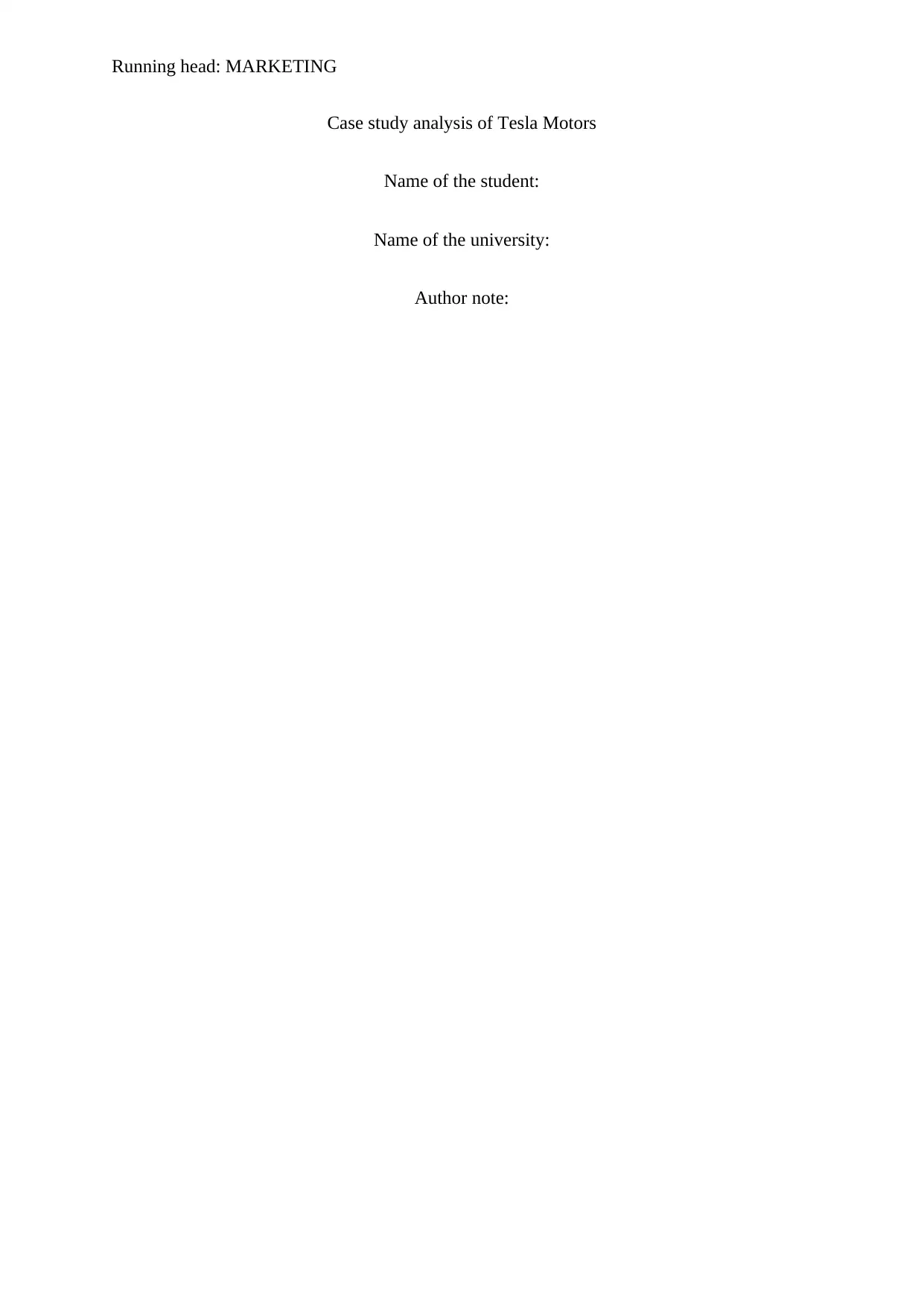
Running head: MARKETING
Case study analysis of Tesla Motors
Name of the student:
Name of the university:
Author note:
Case study analysis of Tesla Motors
Name of the student:
Name of the university:
Author note:
Paraphrase This Document
Need a fresh take? Get an instant paraphrase of this document with our AI Paraphraser

1
MARKETING
Table of contents
1. Capabilities and resource analysis.........................................................................................2
Organizational structure.........................................................................................................2
Management...........................................................................................................................2
Culture....................................................................................................................................3
Financial condition with ratio analysis..................................................................................3
Resource capabilities..............................................................................................................4
2. Description of service offerings.............................................................................................4
3. Value chain analysis of Model S............................................................................................5
4. Competitive strategy of Model S...........................................................................................5
References..................................................................................................................................7
Bibliography...............................................................................................................................8
MARKETING
Table of contents
1. Capabilities and resource analysis.........................................................................................2
Organizational structure.........................................................................................................2
Management...........................................................................................................................2
Culture....................................................................................................................................3
Financial condition with ratio analysis..................................................................................3
Resource capabilities..............................................................................................................4
2. Description of service offerings.............................................................................................4
3. Value chain analysis of Model S............................................................................................5
4. Competitive strategy of Model S...........................................................................................5
References..................................................................................................................................7
Bibliography...............................................................................................................................8
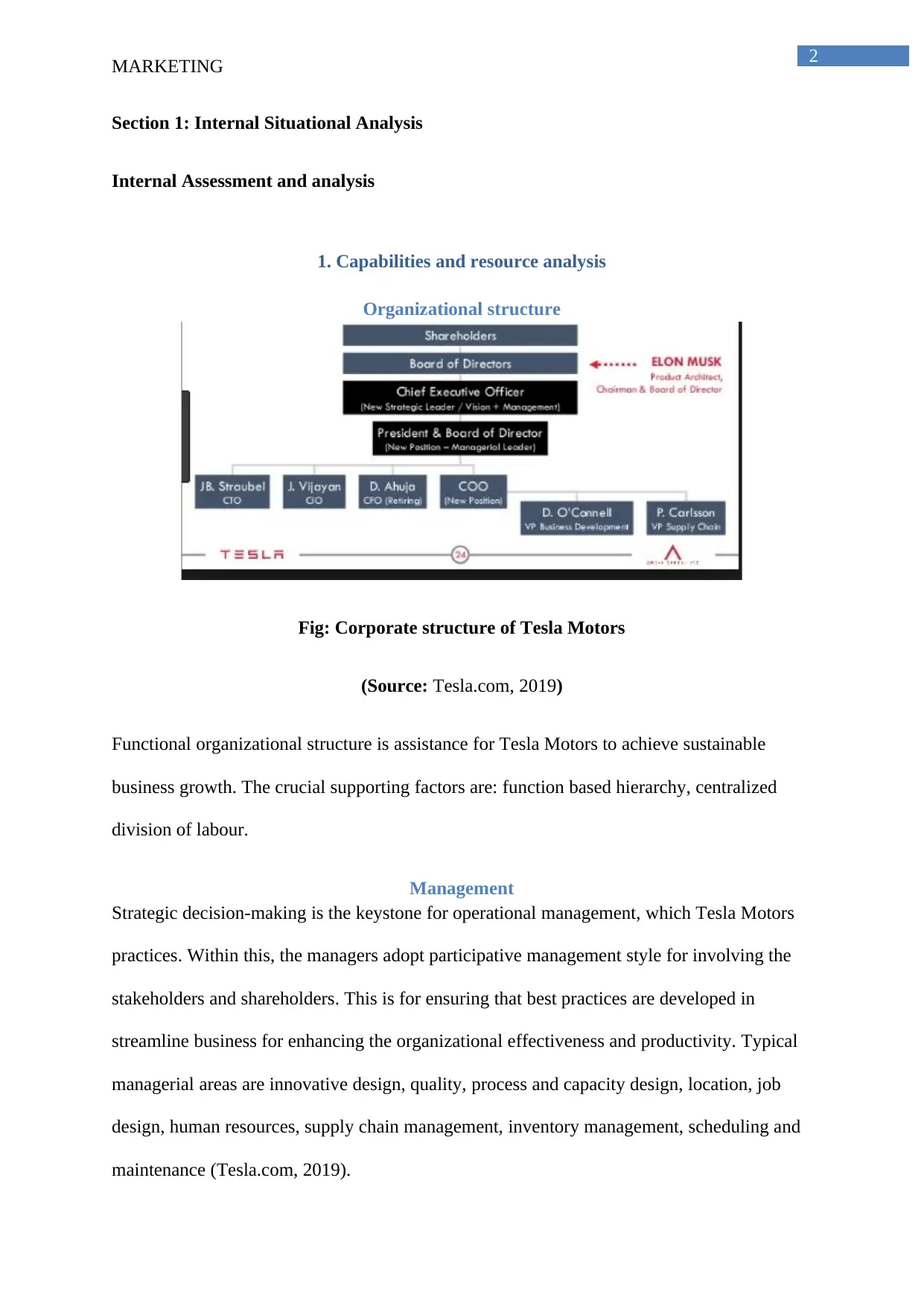
2
MARKETING
Section 1: Internal Situational Analysis
Internal Assessment and analysis
1. Capabilities and resource analysis
Organizational structure
Fig: Corporate structure of Tesla Motors
(Source: Tesla.com, 2019)
Functional organizational structure is assistance for Tesla Motors to achieve sustainable
business growth. The crucial supporting factors are: function based hierarchy, centralized
division of labour.
Management
Strategic decision-making is the keystone for operational management, which Tesla Motors
practices. Within this, the managers adopt participative management style for involving the
stakeholders and shareholders. This is for ensuring that best practices are developed in
streamline business for enhancing the organizational effectiveness and productivity. Typical
managerial areas are innovative design, quality, process and capacity design, location, job
design, human resources, supply chain management, inventory management, scheduling and
maintenance (Tesla.com, 2019).
MARKETING
Section 1: Internal Situational Analysis
Internal Assessment and analysis
1. Capabilities and resource analysis
Organizational structure
Fig: Corporate structure of Tesla Motors
(Source: Tesla.com, 2019)
Functional organizational structure is assistance for Tesla Motors to achieve sustainable
business growth. The crucial supporting factors are: function based hierarchy, centralized
division of labour.
Management
Strategic decision-making is the keystone for operational management, which Tesla Motors
practices. Within this, the managers adopt participative management style for involving the
stakeholders and shareholders. This is for ensuring that best practices are developed in
streamline business for enhancing the organizational effectiveness and productivity. Typical
managerial areas are innovative design, quality, process and capacity design, location, job
design, human resources, supply chain management, inventory management, scheduling and
maintenance (Tesla.com, 2019).
⊘ This is a preview!⊘
Do you want full access?
Subscribe today to unlock all pages.

Trusted by 1+ million students worldwide
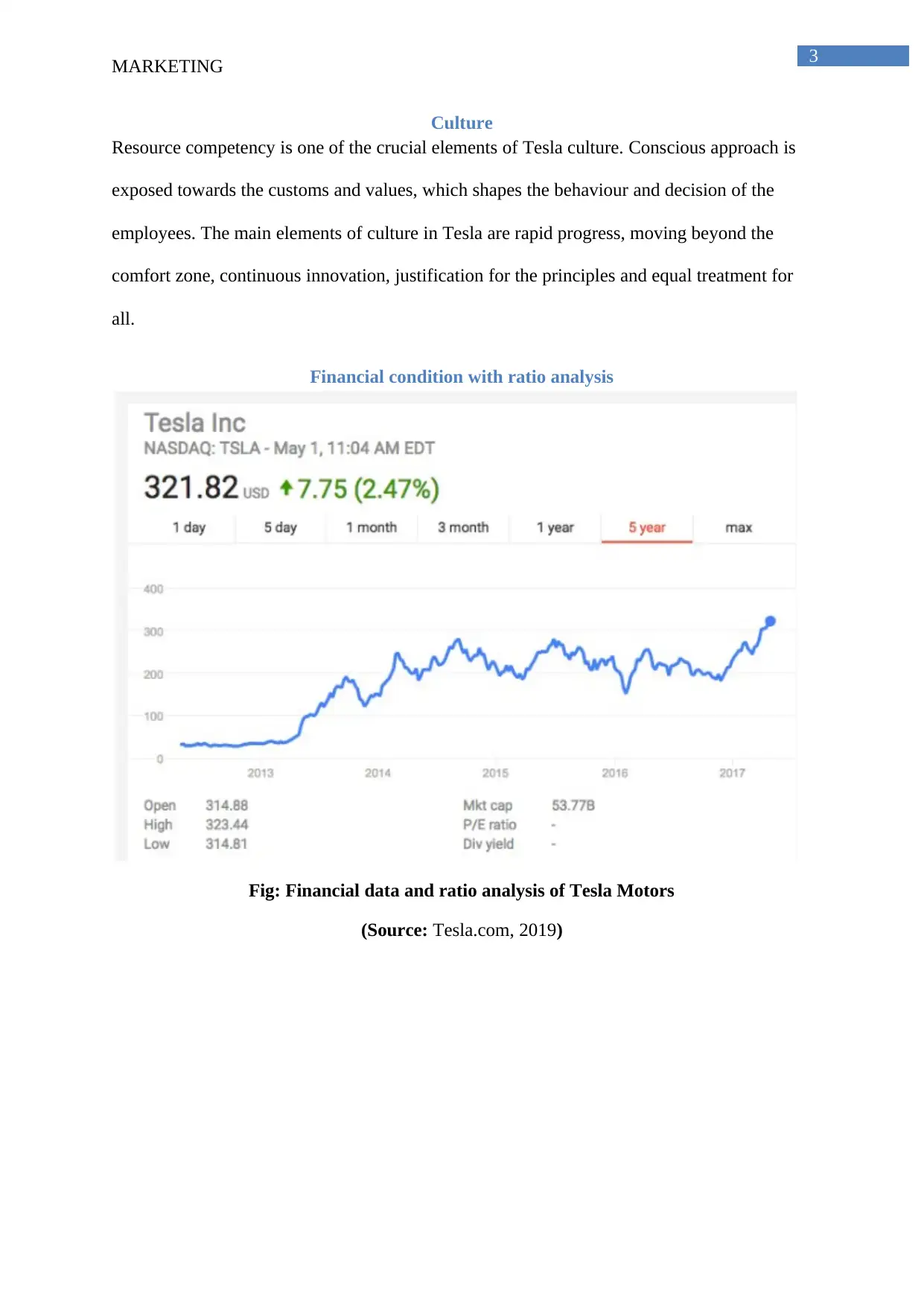
3
MARKETING
Culture
Resource competency is one of the crucial elements of Tesla culture. Conscious approach is
exposed towards the customs and values, which shapes the behaviour and decision of the
employees. The main elements of culture in Tesla are rapid progress, moving beyond the
comfort zone, continuous innovation, justification for the principles and equal treatment for
all.
Financial condition with ratio analysis
Fig: Financial data and ratio analysis of Tesla Motors
(Source: Tesla.com, 2019)
MARKETING
Culture
Resource competency is one of the crucial elements of Tesla culture. Conscious approach is
exposed towards the customs and values, which shapes the behaviour and decision of the
employees. The main elements of culture in Tesla are rapid progress, moving beyond the
comfort zone, continuous innovation, justification for the principles and equal treatment for
all.
Financial condition with ratio analysis
Fig: Financial data and ratio analysis of Tesla Motors
(Source: Tesla.com, 2019)
Paraphrase This Document
Need a fresh take? Get an instant paraphrase of this document with our AI Paraphraser
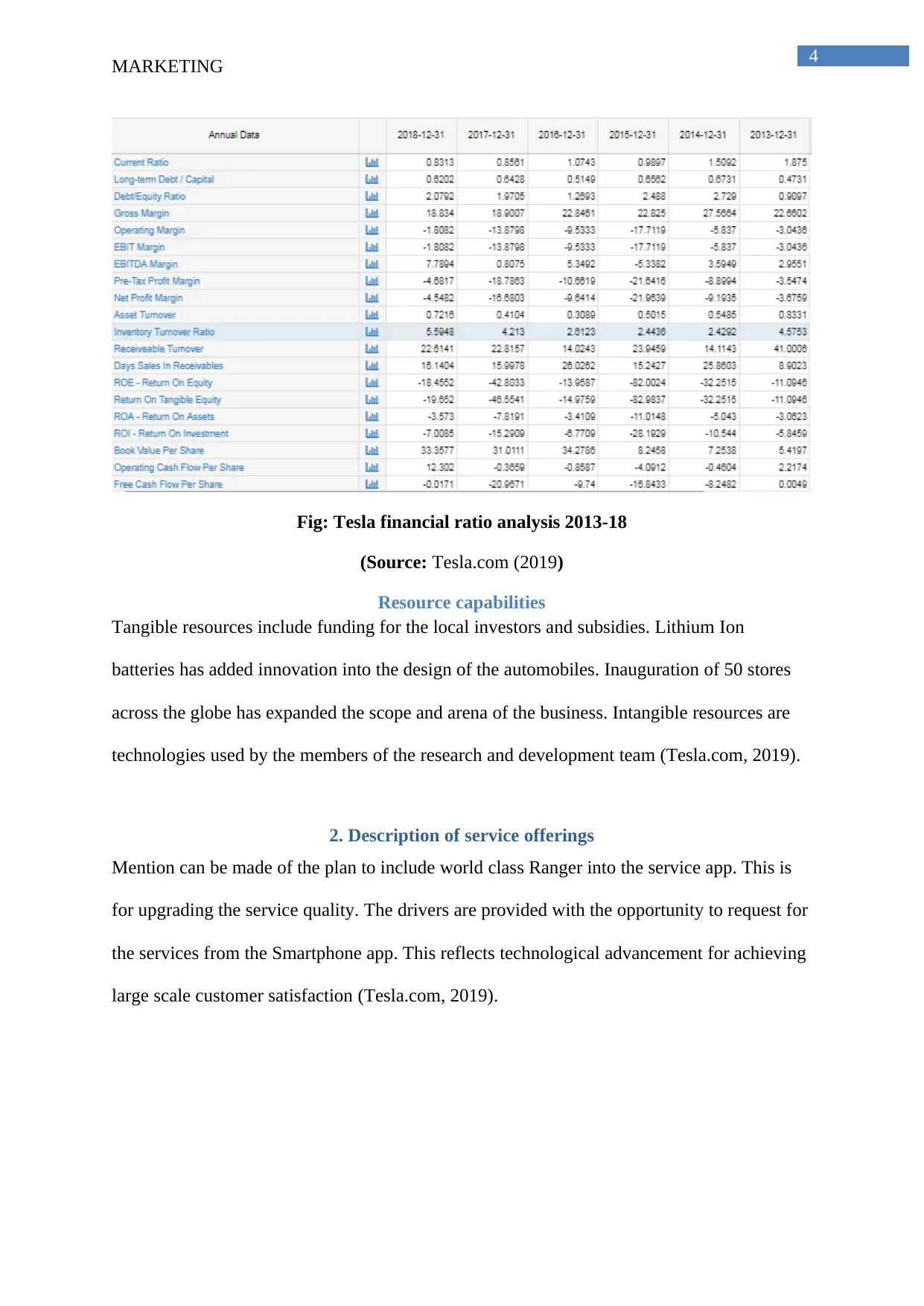
4
MARKETING
Fig: Tesla financial ratio analysis 2013-18
(Source: Tesla.com (2019)
Resource capabilities
Tangible resources include funding for the local investors and subsidies. Lithium Ion
batteries has added innovation into the design of the automobiles. Inauguration of 50 stores
across the globe has expanded the scope and arena of the business. Intangible resources are
technologies used by the members of the research and development team (Tesla.com, 2019).
2. Description of service offerings
Mention can be made of the plan to include world class Ranger into the service app. This is
for upgrading the service quality. The drivers are provided with the opportunity to request for
the services from the Smartphone app. This reflects technological advancement for achieving
large scale customer satisfaction (Tesla.com, 2019).
MARKETING
Fig: Tesla financial ratio analysis 2013-18
(Source: Tesla.com (2019)
Resource capabilities
Tangible resources include funding for the local investors and subsidies. Lithium Ion
batteries has added innovation into the design of the automobiles. Inauguration of 50 stores
across the globe has expanded the scope and arena of the business. Intangible resources are
technologies used by the members of the research and development team (Tesla.com, 2019).
2. Description of service offerings
Mention can be made of the plan to include world class Ranger into the service app. This is
for upgrading the service quality. The drivers are provided with the opportunity to request for
the services from the Smartphone app. This reflects technological advancement for achieving
large scale customer satisfaction (Tesla.com, 2019).
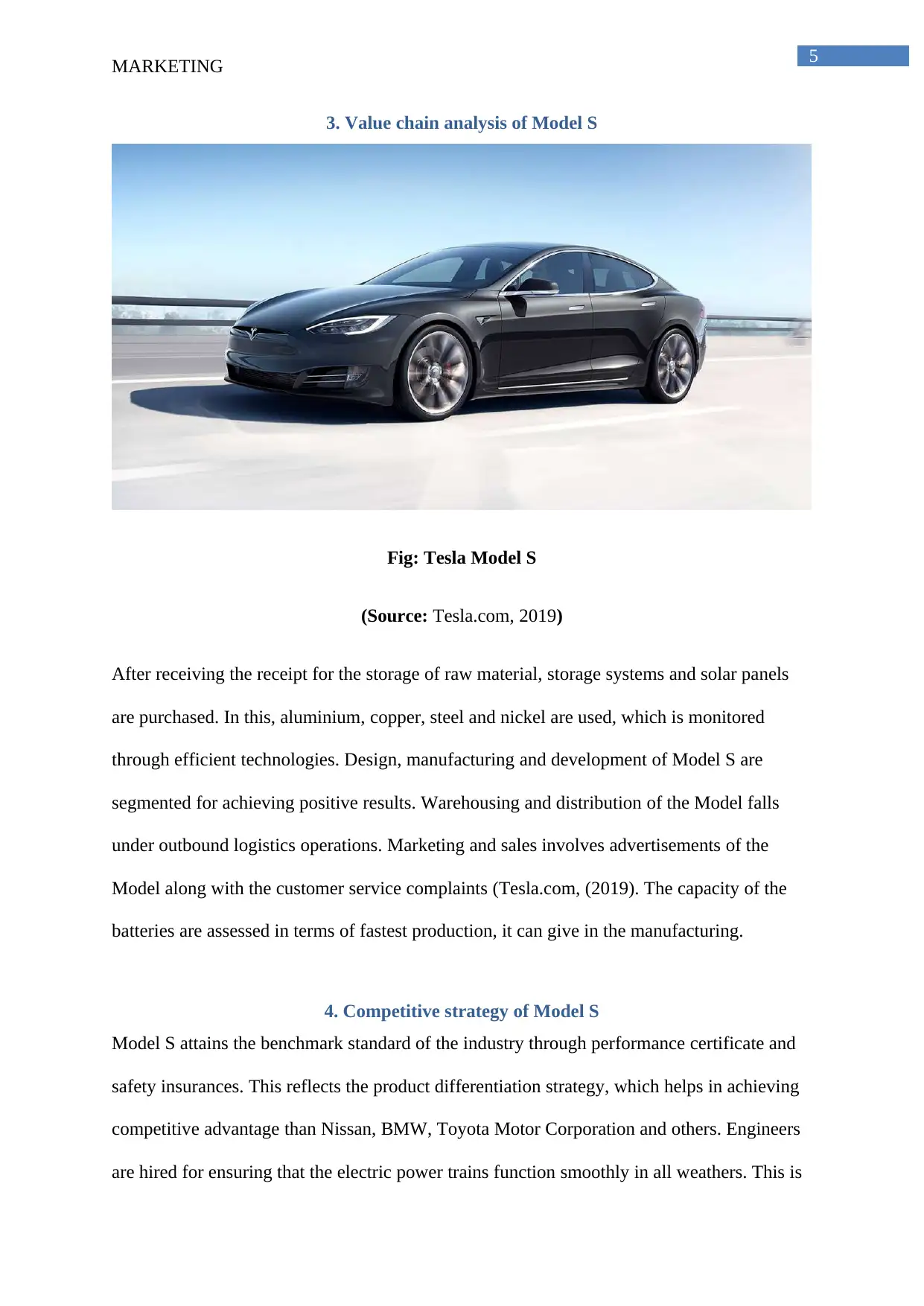
5
MARKETING
3. Value chain analysis of Model S
Fig: Tesla Model S
(Source: Tesla.com, 2019)
After receiving the receipt for the storage of raw material, storage systems and solar panels
are purchased. In this, aluminium, copper, steel and nickel are used, which is monitored
through efficient technologies. Design, manufacturing and development of Model S are
segmented for achieving positive results. Warehousing and distribution of the Model falls
under outbound logistics operations. Marketing and sales involves advertisements of the
Model along with the customer service complaints (Tesla.com, (2019). The capacity of the
batteries are assessed in terms of fastest production, it can give in the manufacturing.
4. Competitive strategy of Model S
Model S attains the benchmark standard of the industry through performance certificate and
safety insurances. This reflects the product differentiation strategy, which helps in achieving
competitive advantage than Nissan, BMW, Toyota Motor Corporation and others. Engineers
are hired for ensuring that the electric power trains function smoothly in all weathers. This is
MARKETING
3. Value chain analysis of Model S
Fig: Tesla Model S
(Source: Tesla.com, 2019)
After receiving the receipt for the storage of raw material, storage systems and solar panels
are purchased. In this, aluminium, copper, steel and nickel are used, which is monitored
through efficient technologies. Design, manufacturing and development of Model S are
segmented for achieving positive results. Warehousing and distribution of the Model falls
under outbound logistics operations. Marketing and sales involves advertisements of the
Model along with the customer service complaints (Tesla.com, (2019). The capacity of the
batteries are assessed in terms of fastest production, it can give in the manufacturing.
4. Competitive strategy of Model S
Model S attains the benchmark standard of the industry through performance certificate and
safety insurances. This reflects the product differentiation strategy, which helps in achieving
competitive advantage than Nissan, BMW, Toyota Motor Corporation and others. Engineers
are hired for ensuring that the electric power trains function smoothly in all weathers. This is
⊘ This is a preview!⊘
Do you want full access?
Subscribe today to unlock all pages.

Trusted by 1+ million students worldwide

6
MARKETING
an initiative towards generating uniqueness within the Model for attracting large number of
customers. Low product costs and high brand loyalty secures the position in the competitive
ambience of the market (Tesla.com, 2019).
MARKETING
an initiative towards generating uniqueness within the Model for attracting large number of
customers. Low product costs and high brand loyalty secures the position in the competitive
ambience of the market (Tesla.com, 2019).
Paraphrase This Document
Need a fresh take? Get an instant paraphrase of this document with our AI Paraphraser

7
MARKETING
References
Tesla.com (2019). About us. Retrieved 19th May 2019 from https://www.tesla.com/
MARKETING
References
Tesla.com (2019). About us. Retrieved 19th May 2019 from https://www.tesla.com/

8
MARKETING
Bibliography
Atkinson, D., 2016. CONCEIVING A MARKETING STRATEGY IN THE ERA OF
DYNAMIC CAPABILITIES. Economic and Social Development: Book of
Proceedings, p.386.
Finne, Å., & Grönroos, C. (2017). Communication-in-use: customer-integrated marketing
communication. European Journal of Marketing, 51(3), 445-463.
Lovelock, C., & Patterson, P. (2015). Services marketing. Pearson Australia.
MARKETING
Bibliography
Atkinson, D., 2016. CONCEIVING A MARKETING STRATEGY IN THE ERA OF
DYNAMIC CAPABILITIES. Economic and Social Development: Book of
Proceedings, p.386.
Finne, Å., & Grönroos, C. (2017). Communication-in-use: customer-integrated marketing
communication. European Journal of Marketing, 51(3), 445-463.
Lovelock, C., & Patterson, P. (2015). Services marketing. Pearson Australia.
⊘ This is a preview!⊘
Do you want full access?
Subscribe today to unlock all pages.

Trusted by 1+ million students worldwide
1 out of 9
Related Documents
Your All-in-One AI-Powered Toolkit for Academic Success.
+13062052269
info@desklib.com
Available 24*7 on WhatsApp / Email
![[object Object]](/_next/static/media/star-bottom.7253800d.svg)
Unlock your academic potential
Copyright © 2020–2025 A2Z Services. All Rights Reserved. Developed and managed by ZUCOL.





